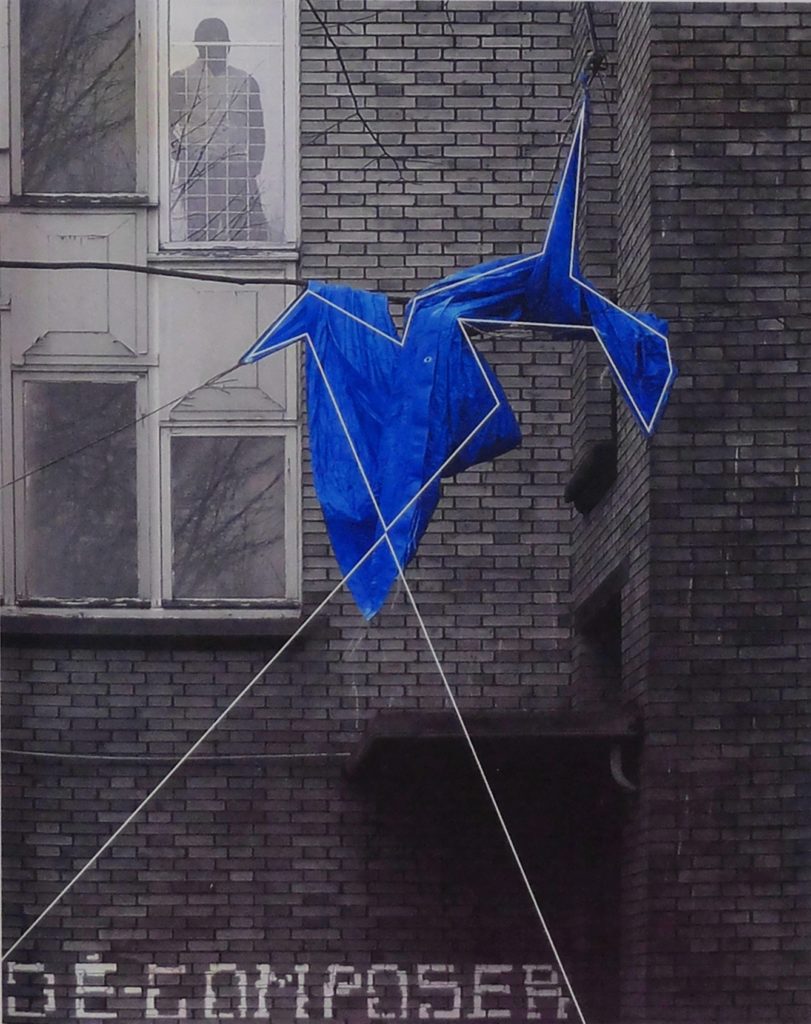Using images to underline the problematics linking people, their daily lives, their culture, their expectations and their urban environment, is a huge temptation to move from urban resilience to pure sociological and philosophical concerns. The task is not easy. The border between the three fields is volatile. The alterity of Levinas is never far nor Bourdieu’s cultural capital. As recalled by S. Uekusa/S. Matthewman (1) , “some non-economic forms of capital, particularly social capital, can also make groups resilient to disasters”, and by E. Klinenberg (2) “ According to Bourdieu, people are active and strategic players who generate and collect capitals, always negotiating their social reality through the dialectic relationship, between habitus and field, even in times of disaster. Indeed, in some disasters, poor groups may cope better than others
The below work is based on one amongst different photos taken at “Les Grands Voisins”, Paris, 2017. The blue canvas was amazingly hanging between trees. I still wonder what could have been its usage before being wrapped around (the wind?). The photograph Claude Iverné took pictures of Sudanese refugees shown at the Aperture foundation in NYC and the same type of blue canvas used as a protecting tent could be seen, underlining its symbolic value. The silhouette outlined in the back has an attitude which inspires something in-between disillusion and expectation. The word “DE-COMPOSER” (to decompose vs to compose) was painted on the wall as shown in the picture, raising the question of the environment contribution in helping to rebound or find a new identity. Is this gentleman a refugee? I do not know but we can guess that his presence in this place has been caused by a disruption, leading to the question which can hardly be answered at this stage: Was the urban environment of “Les Grands Voisins” helpful in achieving a new state of balance more favorable than what prevailed before his move to the place? And if so, how? Can we assume that the successful development of Les Grands Voisins during 3 years is the answer to the question? Does this gentleman own a cultural capital allowing him to react positively to its new urban environment and build a new life? Could he be both vulnerable and resilient as suggested by S. Uekusa / S. Matthewman?
Yky, January 2018, yky@resi-city.com
(1) Univ. of Auckland, Int. Journal of Disaster Risk Reduction, Feb. 2017, http://dx.doi.org/10.1016/j.ijdrr.2017.02.006
(2) A social disaster of autopsy in Chicago, University of Chicago press
“Les Grands Voisins” is a source of inspiration for everyone showing interest in urban resilience, in particular the sociological side. “Les Grands Voisins” was the former Saint-Vincent-de-Paul hospital. When it closed, the town hall of Paris agreed to experiment a new approach based on solidarity, and inclusive development between people. 2 000 persons work and live in the place, a lot of them with limited financial resources. “Les Grands Voisins” should have closed doors at the end of 2017, which was foreseen since it started in 2015, emphasizing the ephemeral dimension of the experimentation. In October 2017, all stakeholders have decided to postpone the closure for a period of 26 months.

More on the above photographic work can be found here